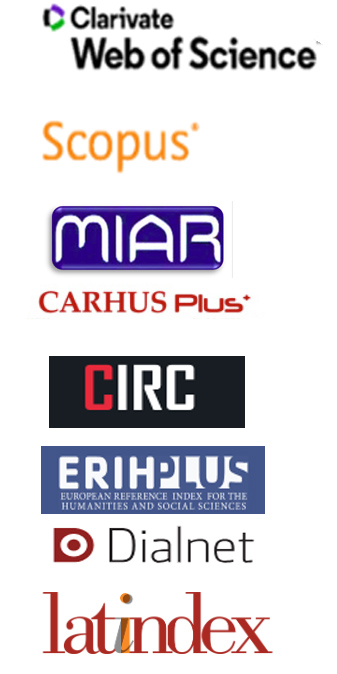Authenticity in contemporary art: what do we conserve?
Resumo
The conservation of contemporary art has generated a tremendous theoretical debate on the criteria followed in conservation-restoration processes and theoretical reflection on what to conserve. In the current theoretical panorama, lines of thought arise that go beyond Cesare Brandi’s Theory of Restoration. New concepts of art such as its meaning, immateriality or impermanence, and the processes of copying, replication, and deferred substitution. These ideas arise from praxis in international forums, where they have tried to find a decision-making model that leads to rigorous and respectful procedures with contemporary art.
Downloads
Referências
ALTHÖFER, H. (1960). “Einige Probleme der Restaureierung moderner kunst”. en Das kunstwerk 5-6 /XIV, nov./dic.
ALTHÖFER, H. (1977). “Fünf Aufgaben zur Erhaltung der modernen kunst”, en Das kunstjahrbuch, 77/78, 149-155.
HUMMELEN, IJ.; SILLEL, D. (1999). “Modern Art: Who Cares? An interdisciplinary research project and an international symposium on the conservation of modern and contemporary art”, Foundation for the Conservation of Contemporary Art
HUMMELEN, IJ. (1999). “The Conservation of Contemporary Art: New Methodos and Strategies?” en Corzo, M.A., Mortality immortality: The legacy of 20th century art, Los Angeles, Getty Conservation Institute, 171-175.
HUMMELEN, IJ. (2006). “Conception, creation and re-creation. Embodied Knowledge and the preservation of contemporary art”, en Delgado, J., Mimoso, J.M., International Seminar. Theory and Practice in Conservation, Lisbon, National Laboratory of Civil engineering.
DEL FRESNO, R. (2017). La entrevista al artista emergente como modo de conservación preventiva. Estudio aplicado a los proyectos Perspectives Art Inflammation and Me y Perspectives, Art Liver Diseases and Me. Tesis doctoral. Universidad Politécnica de Valencia.
JADZINSKA, M. (2008) Authenticity in Modern Art in the light of the theories of Cesare Brandi. en: Basile, Giuseppe. Il pensiero di Cesare Brandi dalla teoria alla pratica. Atti dei seminari di Monaco, Hildesheim, Valeza, Lisbona, Londra, Varsavia, Bruxelles, Parigi. Il prato editore. Padova, 264.
JADZINSKA, M. (2012) “Back to the Future: authenticity and its influence on the conservation of Modern Art”, en Szmelter, I., Innovative Approaches to the complex care of Contemporary Art, Archetype Publications, 82-99.
MARKEVICIUS, T. (2019). “Decision-making authenticating modern and contemporary art: challenges articulating temporality, change and authenticity momentum”, en: MACCH Conference 2019: Bridging the Gap. Theory and Practice in the Conservation of Contemporary Art, 24 – 27 March 2019. Jan van Eyck Academie, Maastricht, The Netherlands.
NACCA (2019). Bridging the Gap. Theory and Practice in the Conservation of Contemporary Art. http://nacca.eu/conference-2019/
PUGLIESE, M. y FERRIANI, B. (2009) Monumenti effimeri. Storia e conservazione delle installazioni, Electa Mondadori, Milán.
PUGLIESE, M. (2002) Scolpire lo spazio: tecnica e metodologia della scultura dall’antichita al contemporaneo, Campanotto., Pasian di Prato.
PUGLIESE, M. y FERRIANI, B. RAVA, A. (2008), “Time, originality and materiality in contemporary art conservation, The theory of restoration by Cesare Brandi, between tradition and innovation”, en 15th Triennial Meeting. New Delhi, ICOM, 484-488. https://www.icom-cc-publications-online.org/1892/Time-originality-and-materiality-in-contemporary-art-conservation-The-theory-of-restoration-by-Cesare-Brandi-between-tradition-and-innovation
BRACKER, A. (2009) Conservation, principles, dilemmas and uncomfortable truths, London, Victoria and Albert Museum.
RAVA, A, (2013) “Forma e memoria, la conservazione dell arte contemporanea”, en Teorie e pratiche del restauro nell arte contemporanea, Skira, Milán, 147-155.
RAVA, A, (2003) “Fragile contemporaneo, en Rapporto restauro”. Il Giornale dell Arte, 219, 4.
SANTABARBARA, C., (2016). “Heinz Althöfer, el inicio de la teoría de la restauración del arte contemporáneo Heinz Althöfer, the beginning of the Theory of Conservation of Contemporary Art”. Revista e-rph18, 52-69. http://revistaseug.ugr.es/index.php/erph/article/view/5198
SCHINZEL, H., (2003). “Visibility of restoration, legibility of artwork : the topicality of a compromise”. En Visibilité de la restauration, Lisibilité de l’œuvre. Actes du 5ème Colloque International de l’Association des Restaurateurs d’Art et d’Archéologie de Formation Universitaire, 13-15 juin 2002. Paris: CRBC-ARAAFU, 55-63
SCHINZEL, H., (2004). “Zeitgenössische Kunst und Restauriertheorie”, in Museum Aktuell Dez. 110, 19 – 27.
SZMELTER, I., SCHOLTER, S., (1999) “The conservation of modern art in Eastern Europe” en Modern Art: Who Cares? An interdisciplinary research project and an international symposium on the conservation of modern and contemporary art, The Foundation for the Conservation of Modern Art and the Netherlands Institute for Cultural Heritage, 322-326.
SZMELTER, I., (2012) “An innovative Complex Approach to Visual Art Preservation” en Innovative Approaches to the complex care of Contemporary Art, Â Archetype Publications London, pp.10-33.
SCHÄDLER-SAUB, U. (2010) “Conserving modern and contemporary art: reflections on theory and practice in Italy”, en Theory and practice in the conservation of modern and contemporary art: reflections on the roots and the perspectives. Archetype publications. https://sisis.rz.htw-berlin.de/inh2011/12398348.pdf
ICOMOS (1994). Documento de Nara. https://www.iccrom.org/sites/default/files/publications/2020-05/convern8_06_docudenara_esp.pdf
SBMK, ICN (2010) “Contemporary art, who cares?”, Foundation for the Conservation of contemporary Art y The Netherlands Institute for Cultural Heritage en colaboración con la University of Amsterdam (UvA), Amsterdam.
UNESCO. (2005) Operational Guidelines for the Implementation of the Word Heritage Convention, World Heritage Committee and World Heritage Centre. https://whc.unesco.org/en/guidelines/
TH KÖLN (2019). The Decision-Making Modelfor. Contemporary Art Conservation and Presentation Mai 2019 Cologne Institute of Conservation Sciences. https://www.sbmk.nl/source/documents/f02_cics_gsm_fp__dmmcacp_190513.pdf
Os autores conservam os direitos de autor e de propriedade intelectual e garantem à revista Ge-Conservación o direito de edição e publicação do trabalho, sob a Creative Commons Attribution License. Este permite a partilha do trabalho, por outros, com o reconhecimento da autoria do trabalho e da publicação inicial nesta revista.
Os artigos podem ser utilizados para fins científicos e formativos, mas nunca com fins comerciais, expressamente, sancionados por Lei.
A informação existente nos artigos é da exclusiva responsabilidade dos autores.
A revista Ge-Conservación e os autores podem estabelecer, em separado, acordos adicionais para a distribuição não exclusiva da versão da obra publicada na revista (por exemplo, colocá-la num repositório institucional ou publicá-la em livro), com o reconhecimento da sua publicação inicial nesta revista.
É permitido e incentivado aos autores difundirem os seus trabalhos, electronicamente (por exemplo, em repositórios institucionais ou no seu próprio site) depois da sua publicação na revista Ge-Conservación, já que pode dar lugar a intercâmbios produtivos, assim como a citações mais amplas e mais cedo dos trabalhos publicados pelo autor.
Os dados pessoais fornecidos pelos autores são utilizados, unicamente, para os fins da revista e não serão proporcionados a terceiros.









